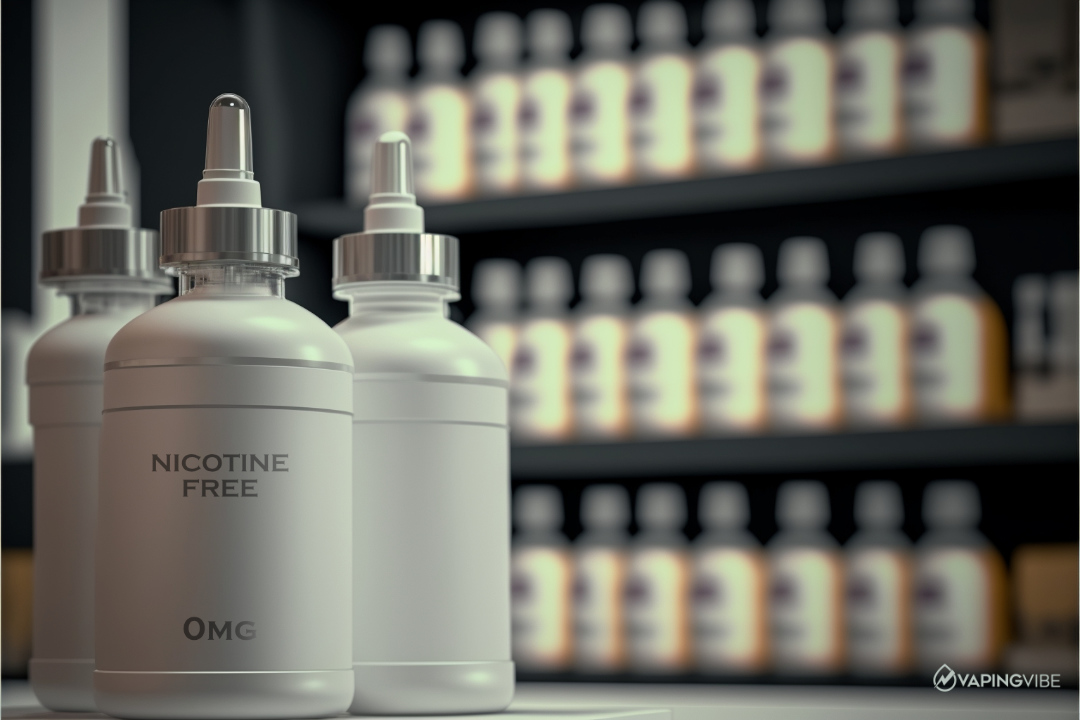What You Need to Know
- There is no proof of significant health risk from secondhand vaping.
- Respect concerns of family and friends, even if secondhand vaping harm is unproven.
- Choose high-quality, non-toxic low or no nicotine vape products free of harmful additives like diacetyl and acetyl propionyl.
- Choose unflavored or mild-flavored vape juices to reduce risk of secondhand exposure to potentially harmful substances.
Electronic cigarettes, also known as e-cigarettes or electronic nicotine delivery systems, have become increasingly popular as an alternative to traditional cigarettes. They work by heating a liquid, which produces a vapor that the user inhales. While e-cigarettes are marketed as a safer alternative to smoking, concerns have been raised about the potential adverse health effects of secondhand aerosol vapor, which is the air that is exhaled by the user and can be inhaled by those nearby.
The question of whether secondhand aerosol vapor is harmful to breathe has been the subject of much debate and research. With the increasing popularity of e-cigarettes, it’s important to have a clear understanding of the potential risks associated with secondhand vapor. In this blog post, we’ll explore the available research on the topic and provide answers to the question of whether secondhand aerosol vapor is harmful to breathe.
By the end of this post, you’ll have a better understanding of what secondhand vapor is, the potential health risk associated with it, and ways to protect yourself and others from exposure to secondhand vapor. Whether you’re an e-cigarettes user, a non-smoker, or someone concerned about the potential health risks of secondhand vapor, this post will provide valuable information to help you make informed decisions.
What is Second hand Vaping?
Secondhand vaping refers to the vapor that is exhaled by users of electronic cigarettes and can be inhaled by others nearby. It is important to note that secondhand vapor differs from secondhand smoke exposure produced by burning tobacco products. When a person vapes, the electronic cigarette heats a liquid, called e-liquid, that contains nicotine and other chemicals. This produces a vapor that the user inhales and exhales. Secondhand vapor is the vapor that is exhaled and can be inhaled by others nearby. It is important to note that the composition of secondhand vape can vary depending on the brand and type of electronic cigarette and e-liquid used.
It’s also crucial to note that secondhand vapor contains significantly fewer harmful chemicals than secondhand smoke. Secondhand smoking is a mixture of the smoke given off by the burning end of a cigarette and the cigarette smoke exhaled by a smoker. Cigarette smoke contains more than 7,000 chemicals, including at least 70 known to cause cancer. Secondhand vapor, on the other hand, doesn’t have the same level of harmful chemicals and particles.

Potential Risks of Secondhand Vapor
While there is still much research on the safety and risks of secondhand vape, some studies have found that it may contain harmful chemicals and particles. For example, a study published in the journal Tobacco Control found that secondhand vapor contains formaldehyde, a known carcinogen, and diacetyl, a chemical linked to a lung disease called bronchiolitis obliterans. Other studies have found that secondhand vapor can contain heavy metals and ultrafine particles that can be inhaled into the lungs.
It’s also important to note that the levels of these harmful chemicals found in secondhand vapor are generally much lower than those found in secondhand cigarette smoke. Therefore, there is no evidence that the levels found in secondhand vapor are high enough to cause harm to human health. Additionally, researchers have found that the levels of these harmful chemicals in secondhand vapor are significantly lower than levels found in smoke from combustible cigarettes.
It’s also important to remember that each person’s experience with vaping is unique, and some people may be more sensitive to secondhand vape than others. For example, people with asthma or other respiratory conditions may be more susceptible to the effects of secondhand vaping.
It’s also important to note that there need to be long-term studies on the effects of secondhand vape exposure. Therefore, more research is required to fully understand the potential risks of secondhand vapor.

Safety Measures to Protect Yourself and Others
To protect yourself and others from potential risks associated with secondhand vapor, there are several safety measures that you can take. One of the most effective ways to avoid exposure to secondhand vapor is to avoid spending time in enclosed spaces where people are vaping. This includes avoiding indoor areas such as homes, offices, and cars where someone may be vaping.
Another essential safety measure is to limit exposure to secondhand vapor in public spaces. This may mean avoiding seating areas near people who are vaping or asking vapers to move away from you.
It’s also important to note that e-cigarettes and vaporizer products are not safe for youth, pregnant women, or adults who do not currently use tobacco products. In addition, these products are associated with an increased risk of nicotine addiction, respiratory problems, and other health risks. Therefore, avoiding exposure to secondhand vapor and vaping products is essential, particularly for young people and pregnant women.
Finally, knowing the laws and regulations regarding vaping in your area is essential. Many places have laws prohibiting vaping in specific public spaces or areas to protect public health. Knowing and following these laws is critical to protect yourself and others from secondhand vapor.
In conclusion, while more research is needed to fully understand the potential risks of secondhand vape, it’s essential to take safety measures to protect yourself and others from exposure. Avoiding passive exposure to secondhand vapor in enclosed spaces, limiting exposure in public spaces, being aware of the laws and regulations regarding vaping in your area, and keeping in mind that e-cigarettes and vaporizer products are not safe for youth, pregnant women or adults who do not currently use tobacco products, are some of the ways to keep safe.

Making the Safe Choice: The Benefits of Low or No Nicotine Vaping Products
Sticking to low or no nicotine vape products can be a smart choice for those who are concerned about the health risks associated with vaping. Nicotine is a highly addictive substance that can have a range of negative health effects, including increasing the risk of heart disease and stroke, and damaging the developing brain in young people.
Vaping products that contain low or no nicotine offer an alternative for those who are looking to reduce their exposure to this toxic substance. These products can still provide the satisfying experience of inhaling vapor, but without the harmful effects of nicotine. This can be especially important for those who are trying to quit smoking, as it can help to reduce cravings and prevent relapse.
In addition to reducing the risks associated with nicotine exposure, low or non nicotine vape products can also be a safer choice for those around you. Secondhand exposure to nicotine can be harmful, especially to young children and pregnant women, and using low or no nicotine products can help to reduce the amount of nicotine in the air.
When choosing a low or no nicotine vape product, it is important to consider factors such as the quality of the product and the ingredients used. Look for products that are made from high-quality, non-toxic ingredients, and avoid products that contain harmful additives like diacetyl and acetyl propionyl. By sticking to low or non nicotine vape products, you can help to protect your health and the health of those around you.

Opt for Unflavored Vape Juices
Flavored vape juices have become increasingly popular in recent years, but they can pose a risk to those who are exposed to secondhand vapor. The flavorings used in these products can contain a range of potentially harmful substances, including diacetyl and other toxic volatile organic compounds (VOCs). These substances can be released into the air when a vape device is used, and can be inhaled by those who are nearby.
In addition to the health risks associated with exposure to toxic flavorings, secondhand exposure to flavored vape juice can also be particularly concerning for children and young people. Many flavored vape juices are marketed with fruit, candy, and dessert flavors that are appealing to young people, and can increase their likelihood of starting to use e-cigarettes.
To reduce the risks associated with secondhand exposure to flavored vape juice, it is recommended to skip these products altogether and choose a vape juice that is unflavored or has a mild, natural flavor. Unflavored vape juice is less likely to contain harmful substances, and will not contribute to the risks associated with secondhand exposure.

Choose a Device with Lower Power and Temperature
Choosing a vape device with a lower power and temperature can help to reduce the risks associated with secondhand vapor. When a vape device is operated at higher power and temperature settings, it can produce a greater amount of vapor and release more particles into the air. These particles can contain a range of harmful substances, including heavy metals, toxic organic compounds, and ultrafine particles.
By using a device with lower power and temperature settings, you can reduce the amount of vapor and particles released into the air. This can help to reduce the risks associated with secondhand exposure, especially for those who are particularly vulnerable, such as young children, pregnant women, and people with pre-existing health conditions.
In addition to reducing the risks associated with secondhand exposure, using a device with lower power and temperature can also be a safer choice for you. Higher power and temperature settings can increase the risk of thermal runaway, which can cause the device to overheat and potentially cause harm.
When choosing a vape device, it is important to consider factors such as the manufacturer’s recommendations and user reviews. Look for devices that are designed with safety in mind, and that have features like temperature control, which can help to ensure that you use the device safely and effectively. By choosing a device with lower power and temperature, you can help to reduce the risks associated with secondhand vapor and ensure that you and those around you are protected.

The Hidden Danger of Thirdhand Exposure
Thirdhand exposure refers to the residual nicotine and other toxic chemicals that can linger in indoor spaces long after secondhand smoke has dissipated. Thirdhand exposure occurs when these substances settle on surfaces and react with other chemicals in the environment, creating new, potentially harmful compounds.
Studies have shown that thirdhand exposure can be a significant health concern, particularly for children, who are more vulnerable to the effects of toxic chemicals. Thirdhand exposure has been linked to respiratory problems, eye irritation, and other health issues, and may also increase the risk of cancer and other diseases over time.
To reduce the risk of thirdhand exposure, it is important to take steps to eliminate residual smoke and chemicals from indoor spaces. This can include thoroughly cleaning surfaces and using air purifiers or ventilation systems to improve indoor air quality. Additionally, it is recommended to avoid smoking in enclosed spaces and to avoid exposing children to secondhand smoke as much as possible. By taking these steps, it is possible to reduce the risk of thirdhand exposure and protect your health and the health of those around you.
Frequently Asked Questions
Is it safe to breathe secondhand vape?
The safety of breathing secondhand vape is still uncertain and a topic of ongoing research and debate. Some studies suggest that secondhand exposure to e-cigarette vapor may contain potentially harmful substances, while others suggest that the levels of these substances are much lower than in traditional cigarette smoke and not a cause for concern. It is important to note that the long-term health effects of secondhand vaping are not yet fully understood and that more research is needed to determine its safety. Until then, it is recommended to take precautions and limit exposure to secondhand vape whenever possible.
How long does secondhand vape smoke stay in your system?
The length of time that secondhand vape smoke stays in your system depends on several factors, including the amount of exposure, the composition of the e-liquid, and individual factors such as metabolism and breathing rate. In general, the particles in secondhand vape smoke are thought to dissipate fairly quickly and not linger in the air for long periods of time. However, some studies have shown that certain chemicals from secondhand vape smoke can persist in the body for a limited time, potentially affecting respiratory and cardiovascular health. Further research is needed to fully understand the duration and effects of secondhand vape exposure in the body.
Is inhaling secondhand smoke worse than smoking?
Comparing the health effects of inhaling secondhand smoke with those of smoking is a complex issue and depends on several factors. While it is generally considered safer than smoking, inhaling secondhand vape smoke may still expose the individual to potentially harmful substances. Secondhand smoke from cigarettes has been well-documented as a health risk, with numerous studies linking it to an increased risk of lung cancer, heart disease, and other serious health conditions. In comparison, the long-term effects of inhaling secondhand vape smoke are not yet fully understood, and more research is needed to determine the extent of the risk. It is recommended to limit exposure to secondhand vape smoke, as well as smoke from traditional cigarettes, as much as possible to reduce the risk of health problems.
What happens if you inhale secondhand smoke?
Inhaling smoke secondhand, whether from traditional cigarettes or e-cigarettes, can have various health consequences depending on the amount and duration of exposure. Secondhand smoke from cigarettes has been linked to an increased risk of lung cancer, heart disease, respiratory problems, and other health conditions. Similarly, inhaling secondhand vape smoke may expose individuals to potentially harmful substances, such as nicotine, heavy metals, and volatile organic compounds.
Short-term effects of inhaling secondhand smoke may include eye irritation, headaches, cough, and respiratory problems. Long-term secondhand exposure, whether from traditional cigarettes or e-cigarettes, may also increase the risk of developing health problems, such as cancer, heart disease, and respiratory disease. It is important to note that the extent of the risks associated with inhaling secondhand smoke is still a topic of ongoing research and debate, and more research is needed to fully understand its effects. To reduce the risk of health problems, it is recommended to limit secondhand exposure as much as possible.
Conclusion
In this blog post, we have explored whether secondhand vapor produced by electronic cigarettes harms breathing. We have defined secondhand vapor, discussed how it is produced by electronic cigarettes, and distinguished it from secondhand smoking. We have also summarized findings from studies on the potential risks of secondhand vapor, mentioning the specific chemicals and particles that have been found in secondhand vapor. We also noted that the levels of these harmful chemicals found in secondhand vapor are generally much lower than in cigarette smoke.
We also provided safety measures to protect yourself and others from potential risks associated with secondhand vapor, such as avoiding exposure in enclosed spaces, limiting exposure in public spaces, being aware of the laws and regulations regarding vaping in your area, and keeping in mind that e-cigarettes and vaporizer products are not safe for youth, pregnant women, or adults who do not currently use tobacco products.
In conclusion, the available research suggests that secondhand vapor is not as harmful as secondhand smoking from combustible cigarettes but can still contain toxic chemicals and particles. Therefore, it’s essential to be aware of the potential risks.

